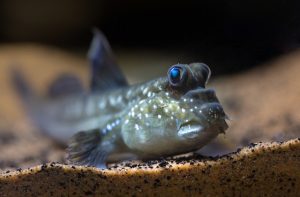
A mudskipper is an amphibious, air-breathing fish (photo credit: National Aquarium).
Guest post: Gretchen Stokes, University of Florida
Air-breathing fishes are those that respire using aerial gas exchange instead of, or in addition to, that of the water. Air-breathing is an ancient vertebrate specialization that evolved from aquatic hypoxia (e.g., areas of seasonally flooded wetlands, under ice). Air-breathing fishes are equipped with one or more modified respiratory structure to breathe, such as modified air bladders, lungs, skin or gills. Some air-breathing fishes (facultative air-breathers) rely mainly on gills with supplemental gas exchange from aerial breathing when conditions are poor or it is too costly to obtain oxygen from water. Other air-breathers (obligate) require continuous, regular surface breathing. Yet another group of air-breathing fishes are amphibious, venturing to land either in an active or inactive state.
Air-breathing occurs in an estimated 450 species and 49 families of fishes, most of which are found in the tropics. In North America, common air-breathing species include gar, tarpon and bowfin. Aquarium enthusiasts may be familiar with the air-breathing habits of well-known betas. Globally the list becomes expansive with many unique adaptations, such as lungfishes, mudskippers, snakeheads or air-breathing catfishes. Whether a gulp of air at the water’s surface, crawling on land to feed, or maintaining a high tolerance to air exposure with specialized skin, air-breathing allows for unique adaptations and survival in extreme environments.
